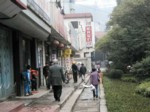
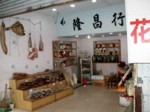
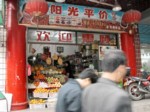
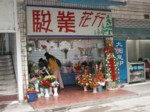
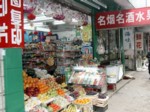
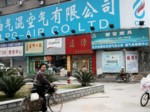
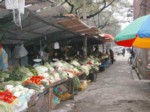
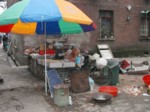
This morning we’re scheduled to visit the Hunan Provincial Museum, which is about 20 minutes from the hotel by bus. On the way Wendy sings us a beautiful song in Chinese and then gives us an overview of the history of the Hunan province. She finishes with a description of the Chinese zodiac. The last Chinese New Year fell on February 12, 2002. Babies born prior to that were born in the year of the Snake, babies born after that (including Hope) were born in the year of the Horse. She outlines the good and bad traits attributed to the horse and snake, and also lists the signs with which they are most and least compatible.
We turn into a gate and then drive through a park-like area to the museum. The museum occupies two buildings which look like they might have been a school at some time in the past. This museum was originally set up to showcase artifacts from the People’s Revolution, but in recent years it's become quite famous as the home of the Mawangdui mummy. During a construction project in the 1970’s workers uncovered a 2000 year old Han dynasty tomb. The amazingly well preserved contents of the tomb, including the naturally mummified remains of the noblewoman who was buried in it, were brought to the Hunan Provincial Museum and put on display.
We enter the building and slip disposable plastic covers over our shoes. The building is dimly lighted and has the feel of long-term neglect. Even when it was first built this building would have been quite drab and institutuional. But it's far from being new and the years haven't been kind - the carpet is worn, the walls are dirty and missing paint, and even though it’s a chilly day there is little or no heat.
We file through several rooms lined with plexiglass cases filled with tomb artifacts, both authentic and reproductions. The tomb contained an amazing amount of stuff - silks, pottery, lacquer-ware, bows, swords, baskets, even food. Wendy guides us through the exhibits and seems to know quite a lot about the things we're looking at. In one of the cases she points out a pair of the noblewoman’s shoes. We expect them to be tiny, but Wendy explains that this woman died over 1000 years before foot binding became popular in China. The sheer volume of Chinese history really hard to grasp for those of us who live in a country which has only existed for a few hundred years. We're surprised to learn that, even though she's a good bit younger than we are, Wendy's grandmother had undergone foot binding as a girl. Although she never saw her grandmother's bare feet, she does recall her tiny shoes.
After looking at all of the tomb artifacts we descend a flight of stairs to the basement where we will view the mummy. The room is fairly dark and two plexiglass domes, brightly lit from below, rising rise from the floor to a height of about 4 feet. Looking into the domes we can see the white tiled floor of the room below which has an antiseptic, operating room look to it. On either side of the first dome are shelves which hold glass jars containing the noblewoman’s internal organs. The organs were removed and preserved during the examination of her mummy. The organs are in a remarkable state of preservation and are easily identified - lungs, stomach, intestines, brain, etc. The mummy itself lies below the second dome, encased in a fluid-filled plexiglass box which rests on a long stainless steel table. She's as well preserved as her innards, but pale and wrinkly - probably from the preservative solution she’s soaking in. Her eyes are closed and her lips are pulled back from her teeth in a kind of a grimace. She seems quite tall, especially for a Chinese woman. We stand and gaze at her for awhile - it’s staggering to think that this woman was alive 2000 years ago!
Back up on the main level we drop our shoe covers in a waiting trash can and cross to a second building through the light rain which has been falling steadily all morning. We climb a broad set of stairs which let out onto a balcony from which we can view, in the large room below, the massive wooden casks in which the mummy was buried. They were unearthed from the construction site where they were discovered, disassembled, trucked to the museum, and then reassembled for display.
On the way back to the hotel Wendy tries to teach us how to sing “Happy Birthday” in Chinese - it’s very slow going. Try as I might, I find it very difficult to pick up even the most basic Chinese words and phrases. The consonant sounds are either very indistinct (I have trouble differentiating “N” and “L” and “R” sounds) or have no English equivalent. There seem to be lots of long, run-on vowel sounds as well. This is made even more difficult by the fact that each sound has a particular tone - rising, falling, high, low. Changing the tone changes the meaning of the word. This is something not found in Western languages and it is very difficult to grasp.
We stop at Pizza Hut on the way back to the hotel to pick up some lunch. Cynthia had taken our orders on the bus ride to the museum and phoned them in ahead of time, so the food is ready and waiting when we arrive. Our veggie pizza is pretty close to what you’d find back in the States, except it includes corn and pineapple as toppings and has a lot less cheese. We've noticed that cheese doesn't seem to be at all popular in China. We've seen it only with omelets from the hotel breakfast buffet and with Western fast-food like McDonalds and Pizza Hut.
After lunch I meet up with Mike and we walk to the little grocery store beside the hotel to restock our supplies. The grocery is part of a two block long strip of shops situated to the left of the hotel. I’m after ramen noodles (cheap and easy to fix in your hotel room), Coke, bottled water, and of course more Guang’s pineapple beer. Picking the noodles is a bit of a gamble - since the packages are labelled in Chinese the only way to tell what flavor you've chosen is by taste. The available flavors seem to range from uncomfortably hot to unbelievably hot. The Hunan province is known for it's firey cuisine, and we quickly learn to add only a tiny portion of the seasoning packet to a bowl of noodles.
We pay for our groceries (the cashier just points to the total on her cash register) and then run into Dave on our way out of the store. The three of us decide to do a little exploring, and continue on to the end of the strip. We pass a fruit store, another grocery, several restaurants that smell wonderful, what appears to be a blood donation center, a shop full of surveying tools (they seem to be oddly popular in Changsha), several book stores, a music & DVD store, a stationery shop, and several other shops whose functions we can’t determine. Some of the shops are quite tiny, no more than 10 ft. x 10 ft. At the far end of the strip we pass through a gate and enter a courtyard which serves as an open air market. Rough wooden stalls line the wall for about a block. It’s mostly fruits and vegetables, including many that we’ve never seen before. The last stall has two large wooden tanks filled with live fish (it doesn’t get any fresher than that) and several slabs of raw meat hanging over a chopping block.
Even though it’s a cold and drizzly afternoon, and even though we’d be in trouble with Cynthia if she found out, we decide to expand our explorations a bit. We take our supplies back to the hotel and then head off in the opposite direction for a return visit to the Changsha Apollo Commercial City. On the way we pass several different men who are selling roasted sweet potatoes. Each has a large iron kettle attached to the side of his bicycle. A fire burns within the kettle, and the potatoes are roasted on a grill over the fire while the bicycle is parked on the sidewalk. The smell is wonderful, especially on such a cold wet day, but we’re very leery of buying food or drinks on the street, so we reluctantly pass by.
We circle each floor of the Apollo, working our way from the first floor to the top. There turn out to be 5 floors of merchandise plus a 6th floor restaurant and the grocery in the basement. The 5th floor (appliances) turns out to be the most interesting. Along with more standard items, there are rows of miniature appliances (refrigerators, washers, and dryers) which are just the right size to fit into the tiny matchbox apartments which seem to be the only type of housing here. The prices are great too – we saw miniature washer/dryer combos starting for less than $100 American. We finish our visit with a trip to the grocery in the basement. They have plenty of formula and baby food, but alas they’re out of pineapple beer - maybe I’ll have better luck tomorrow.
As we wander through the Apollo I find myself studying the faces of the Chinese women we pass by. China is made up of 55 different ethnic groups, and while they’re all obviously Asian, there is certainly no single, definitive, Chinese look. I try to imagine which of these women Hope will look like when she grows up.
| Previous | Home | Next |